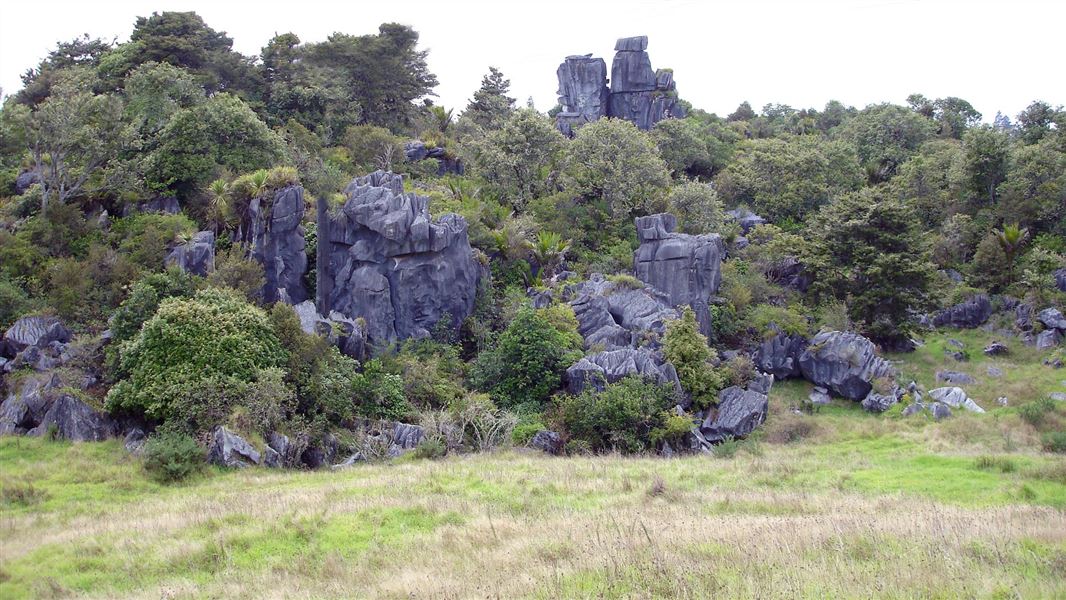
Introduction
Waro Limestone Scenic Reserve is known for its striking limestone formations, but mining coal was in fact the focus of the Hikurangi community from 1895 until the 1950s.Waro is known for its striking limestone formations, but not many people realise that the word 'waro' means 'coal' in Māori. Coal was in fact the focus of the Hikurangi community from 1895 until the 1950s.
In the 19th century, people came to Hikurangi to mill the timber, but they stayed to mine the coal.
With a few false starts - due to lack of transport - the coal mining industry blossomed after 1894 when the railway connected to Hikurangi.
By 1925, the Hikurangi was the most important coal producing area in North Auckland 1. In all, the Hikurangi coalfields were relieved of about 4.5 million tons of coal. Over the years, there were at least five coalmines in the vicinity of the Waro limestone formations.
If you walk the route around the limestone formations, you’ll notice a raised platform faced with limestone blocks around the northern side of the rocks. This was the route of a horse tramline, built at around 1900.
The line connected Kerr and Wyatt’s coalmine to the railway siding to the other side of what is now Lake Waro. Kerr and Wyatt’s was a small mine, operated by a co-operative party of about six men. Skips were loaded with coal at the entrance to the mine, hitched to a horse, and pulled along the tramlines past the limestone formations.
In the early 20th century, there were little cottages tucked right in against the limestone formations. There was a bustling community focussed around the coalmines and the limestone formations. The sense of community was very strong in the early days, and if one family was going through a tough time, others would step in and help.
The Ackers Family Tragedy near Waro Limestone Scenic Reserve
One day in 1933 was a particularly tough time. That day, the brothers Jimmy, Jack and Albert Ackers died after going down a shaft filled with blackdamp, a deadly mixture of gasses that displace oxygen in enclosed spaces.
Bob Ackers, the son of the only Ackers brother to survive, explains what happened. Listen to Bob Ackers (1 minute 37 seconds audio, MP3, 1907K) or read a transcript of the interview below.
Transcript of a segment of oral history interview with Bob Ackers:
“My grandfather bought this mine, and him and my father were down the mine. They were trying to get to an old air shaft that was up on the top road, it used to be where the dump was, and they were trying to connect through to the air shaft.
They sent young Albert up to see if he could hear them tapping, and Albert was only about 18 I think. He decided to go down into the mine, down the air shaft. And of course he got so far down, and he came down with black damp which is a gas that you can’t smell.
It’s said that if someone had made a draft he’d have probably been alright. And anyhow Jimmy, his eldest brother went down to try and get him out and he was overcome and so was Jack the other elder boy. And that’s how they died, with the black damp. And I think Bill Reid was another one that went down but they put a rope around him and managed to pull him out. It was a sad day.
When I was a child I was along playing at Roger’s house along Waro and I could see all the people running over the hill. They ran and caught me and locked me in Roger’s house so I couldn’t go over and see what was happening but I knew there was something wrong. I was only about 5 years old.”
Footnote
1 Ferrar, H. et. al. 1925. Whangarei to the Bay of Islands Geological Survey. Government Printers, Wellington.